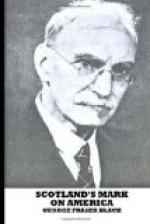of Agricultural Societies in New York. James
Renwick (1790-1862), born in Liverpool of Scottish
parents, was Professor of Physics in Columbia University,
author of several scientific works, and one of the
Commissioners who laid out the early boundary line
of the Province of New Brunswick. His mother
was the Jeannie Jaffray of several of Burns’s
poems. James Renwick, the architect, was his
son. Other gifted sons were Edward Sabine Renwick
and Henry Brevoort Renwick. Joseph Henry (1797-1878),
the “Nestor of American Science,” and organizer
of the American Academy of Sciences otherwise the
Smithsonian Institution in Washington, was of Scottish’
origin. His paternal and maternal grandparents
emigrated from Scotland together and are said to have
landed the day before the Battle of Bunker Hill.
The McAllisters of Philadelphia (father and son) were
famous as makers of optical and mathematical instruments,
and the son was the first to study and fit astigmatic
lenses, and was also the introducer of the system of
numbering buildings according to the numbers of the
streets, assigning one hundred numbers to each block.
Spencer Fullerton Baird (1823-87), Naturalist and
Secretary of the Smithsonian Institution, was also
of Scottish origin. His works, including scientific
papers, number over one thousand titles. Carlile
Pollock Patterson (1816-81) did much to develop the
United States Coast Survey. William Paterson Turnbull
(1830-71), ornithologist, author of the “Birds
of East Pennsylvania and New Jersey,” a model
of patient and accurate research, was born at Fala,
near Edinburgh. Edward Duncan Montgomery, biologist
and philosopher, was born in Edinburgh in 1835.
Marshall MacDonald (1835-95), ichthyologist, pisciculturist,
and inventor, engineer in charge of the siege of Vicksburg
during the Civil War, and inventor of automatic hatching
jars, was the grandson of a Scottish immigrant.
Peter Smith Michie (1839-1901), soldier and scientist,
born in Brechin, Forfarshire, graduated from West
Point in 1863, served as Engineer in the Federal Army,
and was afterwards Professor of Natural and Experimental
Philosophy at West Point. William Healey Dall
(b. 1845), palaeontologist to the United States Geological
Survey, author of “Alaska and Its Resources,”
and author of hundreds of articles on Natural History
subjects, was a grandson of William Dall of Forfarshire.
Thomas Harrison Montgomery (1873-1912), specialist
in zoology and embryology, was of Scottish origin.
Robert Gibson Eccles, physician and chemist, born
in Kilmaurs, Ayrshire, in 1848, discovered that benzoic
acid and the benzoates are excellent preservatives
of food. He has been Chemist of the Department
of Indian Affairs, Professor of Chemistry in the New
York School of Social Economics, President of the
New York Pharmaceutical Association, etc., and
has written largely on philosophy and science.
Stephen Alfred Forbes (b. 1844), naturalist, educator,
and writer on entomology and zoology, is of Scottish




